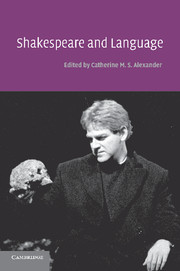Book contents
- Frontmatter
- Contents
- List of contributors
- Editor's note
- 1 Shakespeare and language: an introduction
- 2 Shakespeare's language and the language of Shakespeare's time
- 3 The foundations of Elizabethan language
- 4 Shakespeare's talking animals
- 5 Some functions of Shakespearian word-formation
- 6 Shakespeare and the tune of the time
- 7 Shakespeare's Romeo and Juliet: the places of invention
- 8 Shakespeare's thematic modes of speech: Richard II to Henry V
- 9 Hamlet and the power of words
- 10 The art of the comic duologue in three plays by Shakespeare
- 11 Hamlet's ear
- 12 ‘Voice potential’: language and symbolic capital in Othello
- 13 The aesthetics of mutilation in Titus Andronicus
- 14 ‘Time for such a word’: verbal echoing in Macbeth
- 15 Household words: Macbeth and the failure of spectacle
- 16 Late Shakespeare: style and the sexes
- Index
16 - Late Shakespeare: style and the sexes
Published online by Cambridge University Press: 15 December 2009
- Frontmatter
- Contents
- List of contributors
- Editor's note
- 1 Shakespeare and language: an introduction
- 2 Shakespeare's language and the language of Shakespeare's time
- 3 The foundations of Elizabethan language
- 4 Shakespeare's talking animals
- 5 Some functions of Shakespearian word-formation
- 6 Shakespeare and the tune of the time
- 7 Shakespeare's Romeo and Juliet: the places of invention
- 8 Shakespeare's thematic modes of speech: Richard II to Henry V
- 9 Hamlet and the power of words
- 10 The art of the comic duologue in three plays by Shakespeare
- 11 Hamlet's ear
- 12 ‘Voice potential’: language and symbolic capital in Othello
- 13 The aesthetics of mutilation in Titus Andronicus
- 14 ‘Time for such a word’: verbal echoing in Macbeth
- 15 Household words: Macbeth and the failure of spectacle
- 16 Late Shakespeare: style and the sexes
- Index
Summary
Shakespeare's turn from tragedy to romance coincides with a similarly radical change in the style of his verse. This complicated and self-conscious poetry has attracted a wide variety of labels, from Baroque to incompetent to post modern, but it has not been carefully described nor have its implications been adequately assessed. These metamorphoses of dramatic mode and verse style are partly attributable to Shakespeare's evolving and contradictory opinions about language itself, and the late tragedies, especially Antony and Cleopatra and Coriolanus, are a good place to start in studying these changes because together they constitute a kind of hinge or pivot on which Shakespeare turns from one kind of drama to another. For my purposes, their particular utility derives from their dependence upon similar conflicts of gender that not only help to forecast Shakespeare's narrative and thematic interests but also influence the kind of poetry he will devise for the final phase of his career. Recent criticism has begun to establish that, historically speaking, certain expressive styles could be sexually coded, and I shall draw upon some of that work to assert that what we witness in the final phase of his career is the feminization of Shakespeare's dramatic and poetic style.
The argument that follows, simply stated, is that the complex verse patterns of the late plays are intimately related to Shakespeare's imaginative recovery of the feminine, that the origins of these thematic and stylistic conflicts emerge clearly in the last classical tragedies, and that the romances constitute a conditional resolution of these concerns.
- Type
- Chapter
- Information
- Shakespeare and Language , pp. 266 - 289Publisher: Cambridge University PressPrint publication year: 2004



